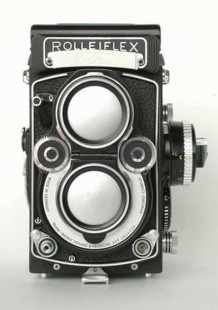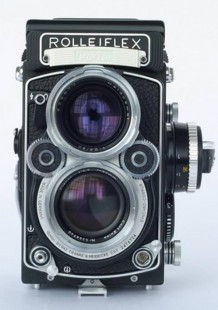This article was originally published in ‘PHOTONpro’ - ‘Kitchen’s Cupboard’ and is reproduced here by kind permission of the Author.
Over the years I have owned four 6 x 6cm Rolleiflexes... and for reasons which at the time seemed sensible. I sold them. Each time, suffering withdrawal symptoms, I bought a replacement, the last being the subject of this article. If I had to settle for but one camera of the many I have owned, it would be a metered 2.8F Rolleiflex.
So what is it about a Rollei that affects me this way? There are several reasons. I like the square 6 x 6cm format, allied to looking down into the viewfinder screen showing, effectively, a bright clear ‘transparency’ of the subject. Eye up against the focusing magnifier, I become absorbed in what I see, almost completely isolated from my surroundings. The psychology of all this is hard to explain to those who use only 35mm SLRs, but in practice, where it matters, it works superbly well.
Quality is apparent as soon as you pick up a Rolleiflex. Even well-used models possess this intangible quality. The results, provided focusing and exposure are correct, are superlative. It is possible to use a Rollei at shutter speeds impossible with a medium format SLR. Why? Minor vibration. Yes, even the best vibrate be it ever so little, as the mirror hits its stops. In practiced hands a Rollei is safe at 1/30th, and usually safe at a 1/15th, which is more than can be said of any roll film SLR.
The Zeiss Planar and Schneider Xenotar were the best lenses available. It has been claimed that the Planar was the better lens, but in my experience this is not demonstrable by taking photographs. The one lens one rarely hears about is the f 2.8 80mm Tessar fitted to the Rolleiflex 2.8A of 1951: Clan Rollei glosses over duff lenses as readily as Clan Leica! This highly unsatisfactory lens, one definitely best left to collectors, was soon replaced by a f 2.8 Zeiss Jena Biometar, the model being designated Rolleiflex 2.8B. 2.8A introduced the new bayonet III filter mount. The Rolleiflex 2.8C of 1953 with Schneider Xenotar restored confidence in the 2.8 series, the 2.8 Zeiss Planar completing the job in 1954.
My ‘model 5’ Xenotar-lensed 3.5F is of 1979 vintage. The focusing hood lifts up at the rear edge, and can be collapsed by squeezing the sides. It can also be removed in order to fit an eye level prism. The focusing screen has a 1cm grid and provides a bright contrasty view of the subject. A split image rangefinder assists precise focusing. A moving mask under the screen provides parallax correction. The front flap holds flat to provide direct vision viewing, with focusing (of an inverted image) via a mirror attached to the flap.
The Synchro-Cornpur shutter provides speeds from 1 second to 1/500th, and enables electronic flash to be used at all speeds, bulbs with the customary 18-20mS delay, plus delayed action. A sliding switch permits multiple exposures. Moving the shutter beyond the 1 second mark brings into view figures in green, doubling from 2 seconds to 60 seconds. These are not shutter speeds. Instead they are all the `B’ setting of the shutter, and act as metered times for exposures longer than 1 second.
The Rollei’s exposure meter is set into the focusing knob, which also bears a unique and most effective DOF indicator: a white band expands and contracts in accordance with the aperture set.
The exposure meter needle and ‘follow’ pointer appear in an arc on top, clearly visible in use. Coupled to both shutter and aperture knobs, it is calibrated for film speeds from 12 ASA to 1600 ASA. Along with their DIN equivalents these appear in the filter factor setting knob, by means of which filter factors up to three stops, can be set in half stop increments. For incident light work a diffuser can be clipped over the meter’s cell.
Film loading is automatic, assisted by a removable back. Thread the leader under the film sensing feeler roller, attach it to the take up spool, close the hack, operate the lever wind forward until it stops. Reverse the lever to cock the shutter and you’re in business. Photographers who also use 120 SLRs can forget the loading sequence and ignore the feeler roller. The result is a wasted film and a feeling of utter foolishness.
The early SLR Hasselblad with its TTL viewing, interchangeable lenses and film magazines, offered versatility the Rolleiflex could not. When Victor replaced his quirky focal plane shutter with time-proven Compur Rapids, then Syncho Compurs to provide flexibility to users of flash, the TLR Rollei’s fate was inevitable.
Despite changes to company name, reorganisation, and the acquisition of Schneider, ownership finally passed from German to Korean hands. The new Samsung-led Rollei puts 35mm first with new £1,500 compacts, and all 6 x 6cm Rolleiflexes are collector’s items for the future.

